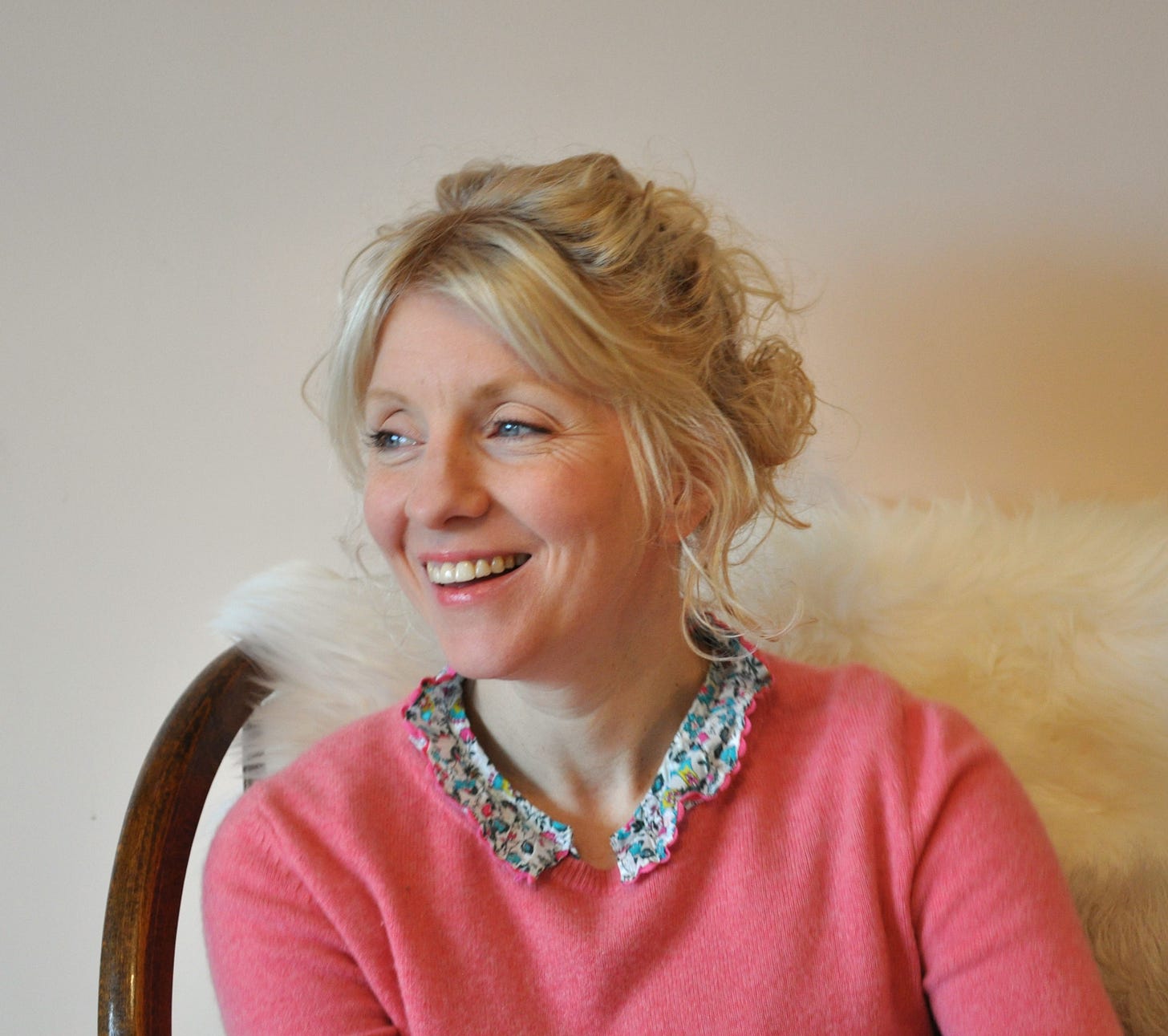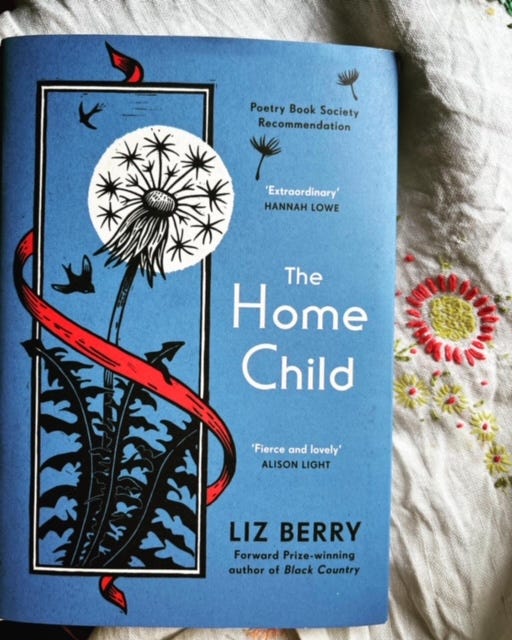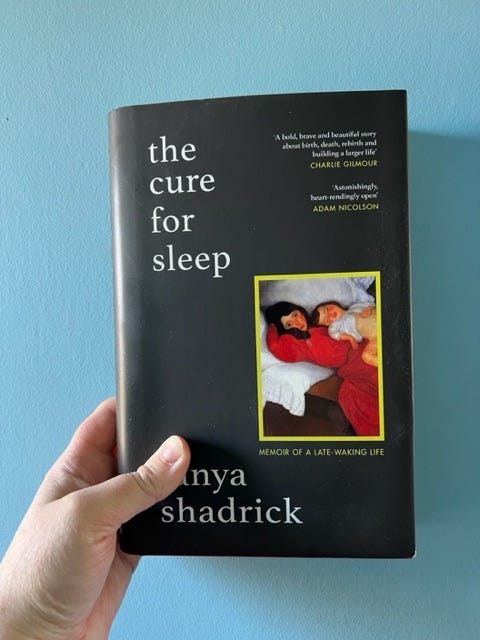Liz Berry Answers Questions on The Home Child
Plus Tanya Shadrick's The Cure for Sleep is our May book choice!
First of all, thank you so much for the kindness, messages, shares and comments on last weeks post:
Poem for my daughter, on what would have been her thirteenth birthday.
Thirteen years ago about this time (7.20am) I was pregnant in a hospital room, waiting for my husband to pick me up so we could go to another hospital to see why our baby was measuring smaller than she should, why she wasn’t moving as much as she should. I’d had steroid shots to prepare my body and her body, but there seemed little rush to the day. In h…
I went out for the day and did what I said I would do, climbing the Wolds, letting myself feel close to my daughter as I visited the site of a Neolithic child burial. More about that in the book (did I mention I have a book out next year?) it was a particularly soul enriching day and I think one of the best celebrations of her short, but significant life.
Liz Berry Questions and Answers
The book club, Books from the Margin, had its first zoom book chat on the 16th. It was glorious. Everyone was excited and generous with their responses to Liz Berry’s The Home Child and the hour passed in a buzz of sharing favourite parts, questioning the differences between themed poetry collections and ‘novel in verse’ discussing the impact of cover art and illustrations and recommending books to each other. Next time I’ll take care to write the recommendations down and share them here, as not everyone can make the zoom events, and I want to keep BFTM (Books from the Margin) as accessible as possible. We’ll be meeting on zoom again tomorrow evening 7pm-7.45pm where I’ll be chatting to Liz herself, she’ll be giving a reading from the book and you will have chance to ask her some questions. Tickets are on sale until the day of the event - 28th April. Want to join us? Book your ticket here - it’s pay what you can between £1 and £10
Liz has been extremely generous with her time and has asked for donations to Women’s Aid in lieu of a fee. You can do that using this button:
Liz very kindly agreed to, as well as coming along to give a reading tomorrow, answer some written questions on The Home Child. Here they are. As ever, eloquent and thoughtful in her responses. Enjoy:
1. The Home Child feels like an attempt to right the wrongs of historical forced immigration, or at the least to acknowledge those historical wrongs. At the same time, it doesn’t feel like any sort of political statement on the rights and wrongs of child immigration, it feels like a very personal story. What were your intentions when you set out to write the book, did you find this aspect challenging?
That’s such an interesting question! When I first began writing the poems that became The Home Child, I don’t think I had any clear or definite intention, only a feeling that I wanted to honour Eliza’s life in some way and not allow it to disappear into the darkness of the past unmarked. I knew her story was a sad one so I made myself look for moments of light and tenderness, so we can feel Eliza’s humanity. Twelve-year-old girls are full of curiosity and wonder, defiance and spark, and I wanted the reader to feel that.
Through the book’s factual introduction and my use of archive-based material, I hope I give readers the information they need to make up their own minds about the Child Migration schemes. One of the most interesting parts of my journey with The Home Child has been chatting to others about it and hearing their opinions. It’s surprising and often troubling how relevant the issues in the book feel.
2. The Home Child is described as ‘a novel in verse’. In your opinion, what is the difference between a heavily themed or narrative poetry collection and a ‘novel in verse’.
I think of The Home Child as a story told through poems, a narrative you follow from beginning to end. I wanted it to be a book you can read with pleasure and absorption, as you might read a short novel. I also very much wanted it to reach readers who might not normally choose poetry (this is almost always something I think of when I’m making a book). By calling The Home Child a novel in verse, I hope we foreground its storytelling and make it feel approachable for readers. The other options we considered were verse novel (which didn’t feel quite right as it's individual linked poems rather than one continuous flow of verse) and book-length-poetic-sequence (which sounds a bit dry and difficult!) I tried to imagine my mom – a very keen general reader – picking up The Home Child in a bookshop or library, and I wondered which of those descriptions would draw her in and it was definitely ‘novel in verse’.
3. How long did it take to research the book and where did you start?
I researched on and off for a good few years and continued after the writing had begun, the two didn’t feel separate. The research was fascinating and incredibly moving, sometimes unbearably so. I was writing the book while looking after my own young sons, themselves the same age as some of the younger Home Children. Their vulnerability seemed heartbreaking.
Alongside Eliza’s Middelmore records and census records, I read countless first-hand accounts and interviews by British Home Children and their families. I also read novels, poems, non-fiction books, anything I could to immerse myself in that experience. I tried to understand exactly what daily life would have been like in Cape Breton at the time, right down to the clothes Eliza would have worn, how she would have done her laundry, the flowers she would have seen in the fields…
And then at some points I had to let that go and allow my imagination to run.
4. If Eliza was alive today, what would you say to her?
We remember you. We’re so sorry for what happened to you.
5. How does the writing of The Home Child compare to your other works of poetry?
I like to imagine there’s a thread that runs through all my books and allows my reader to travel along with me from poem to poem, project to project, even though the subjects might be very different. One of those threads is Black Country dialect but there are others too.
However, this book did feel different to write. I began by working poem to poem, as I always do, but as the collection grew and began to form a narrative I had to consciously think about how to structure it, what to tell and what to leave out, pace, character, moments of light and shade etc. My editor at Chatto is also a fiction editor and so was helpful but at points I felt very challenged and out of my depth! To help myself move forwards, I did two things. Firstly, I asked the poets of Twitter for their advice about writing a long poetic narrative. People were wonderfully generous with their responses and gave me book recommendations, tips, essays to read… Completely invaluable! Secondly, I asked a few poets I know and admire for their advice. I approached people who were very different from each other but who all had the skill of telling stories through their poems. I think you should never be afraid to ask for help or to be a learner again as there’s so much to be gained.
6. How disciplined were you while writing the book, what’s your writing routine?
I am a disciplined writer in the sense that I’ve always written in the margins of my life – at first when I was teacher, then as mom of young children, now alongside freelance and adult education work. I think that necessary compression of my writing time has made me disciplined. I wrote much of The Home Child during the dreadful Winter lockdown. Nursery and school agreed to take the children for two days a week (my partner’s a key worker) and I was so profoundly grateful that I began writing at 9am every day and worked without distraction until 3pm. I felt totally immersed in the world of the book and sometimes worked on it at night too.
Usually, I don’t have any typical writing routine as I’m freelance, so every week looks different. I try to write a few times a week in my notebook, for pleasure or release, and will work at something more deeply when the children are at school, and I’ve got a quiet day at home. Before I had the boys I often used to go on retreat and found that solitude incredibly helpful and productive.
7. The language of belonging features heavily throughout The Home Child. I’ve read that dialect is very important to you as a person and as a writer and have always admired your use of colloquialisms and dialect in your work. How much is dialect-based language a part of ‘belonging’ for you?
I adore Black Country dialect – gutsy, earthy and unexpectedly lyrical. A great part of my mission as a poet is to show it as a beautiful language, a tender one. That feels important to me and important politically too. Dialect can make us feel a sense of ‘belonging’, a deep connection to home and others, but it can also be a form of defiance or resistance, a way of ‘shutting out’. I’m interested in all those possibilities.
In The Home Child there’s some gorgeous old words: donny (hand), canting (talking), tranklements (bits and bobs) but I think my favourite is the word wum, an old Black Country way of saying ‘home’. It feels so warm to me, so perfectly held in the mouth when you speak it, and sonically it’s also very close to the word ‘mom’, which takes on great meaning for Eliza as she loses both her mother and her home in quick succession.
8. What was the experience of visiting Eliza’s memorial stone in Nova Scotia like?
I traced Eliza’s journey from Birmingham to Nova Scotia while on a literary pilgrimage to Green Gables, home of L.M. Montgomery’s Anne. It was very moving: holding those two twelve-year-old orphan girls in my head, Eliza’s story a shadow to Anne’s. Eliza is buried in a small rural site in a beautiful setting in Cape Breton, incredibly quiet and wild. It seemed such a long way from the Black Country. I didn’t know then that I would write a book about Eliza, but I did feel very affected, haunted almost, by her story and knew it would stay with me.
9. How important to the overall ‘feel’ of the book is the design and how much input did you have in that part of the book’s journey?
Luckily for me, Chatto make beautiful books and the care and attention they gave to The Home Child made me feel very honoured. I’d never had a hardback before and never had illustrations so that was a real thrill, especially to work with Gemma Trickey who made the lino-prints for the cover and the internal illustrations. I wanted the book to be a beautiful object, a treasure to hold. In a time when we can read almost everything in a whizz online then the sensual pleasure of a real-life book carries even more power. I was very inspired by those beautiful old Edwardian hardbacks with their lush colours and black ink illustrations. My youngest son Ted chose the colours for the cover. We looked at all the options together and he deemed the deep blue with the moon behind the dandelion the “most magical”!
10. Did you have any struggles with the writing process, or doubts about the book as a whole?
Yes, yes and yes. See above! Making a book is always a nerve-racking and doubtful process for me and I was extra mindful when making The Home Child as I was telling someone else’s story. These were real things that happened to real people, and I wanted to honour that and do my very best for them.
Books from the Margin May Book Choice
For May we will be reading and chatting about Tanya Shadrick’s The Cure for Sleep. This is a beautifully honest and open account of one woman striving to plant herself in her own life, to reawaken herself. After a near death experience Tanya finds herself contemplating what is important to her and the life that she, perhaps, has been sleepwalking through. It’s an exceptional and sometimes challenging book in which the author does not shy away from exposing herself as a whole person. I cannot wait to chat with others about this book. This book was a huge influence in me taking myself seriously as a writer and embracing my true self. The paperback edition comes out this week (28th April) and, thanks to the generosity of the Poetry Pharmacy, I am able to offer a discount code for 15% off when you sign up for any of the live events.
Sunday 14th May 10-11am the book club will be meeting on zoom to chat about Tanya Shadrick’s The Cure for Sleep. Join me to discuss the book at our Sunday Morning book chat group. Please feel free to come along, even if you've not read the book. The group is a chance to talk books in general too, and to be part of a book appreciation community.
On Friday 26th May 7-7.45pm (UK time) I’ll be joined by Tanya herself to chat about her book. Both these events are ‘pay what you can’ events £1-£10
Hope to see you on Friday night!
With love
Wendy
x





